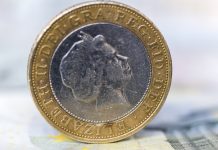The pound started out strong versus the dollar yesterday at 1.3518 and continued to get even stronger by the end of the day. The pound starts Wednesday at 1.3603, its highest level over the dollar in a year.
| What do these figures mean? |
|---|
|
When measuring the value of a pair of currencies, one set equals 1 unit and the other shows the current equivalent. As the market moves, the amount will vary from minute to minute. For example, it could be written: 1 GBP = 1.28934 USD Here, £1 is equivalent to approximately $1.29. This specifically measures the pound’s worth against the dollar. If the US dollar amount increases in this pairing, it’s positive for the pound. Or, if you were looking at it the other way around: 1 USD = 0.77786 GBP In this example, $1 is equivalent to approximately £0.78. This measures the US dollar’s worth versus the British pound. If the sterling number gets larger, it’s good news for the dollar. |
Manufacturing pmi (purchasing manager’s index) data was released yesterday to waiting investors. While US data came slightly in stronger than analysts expected, and UK data slightly weaker, the pound continued to push above its dollar counterpart. UK manufacturing, despite the slight drop, still came in as the strongest 3 months of growth since 2014, a win for sterling. With the new US tax bill failing to make the impact investors hoped, US manufacturing pmi data only managed to slow the dollar’s downfall, rather than boost it.
The manufacturing pmi data tracks purchasing managers’ activity in manufacturing sectors. If numbers are over 50, it indicates industry expansion. Traders watch these numbers closely as they may be early indicators of the overall health of a country’s economy as purchasing managers likely have access to company data and will spend accordingly.
| Why does strong economic data boost a country’s currency? |
|---|
| Solid economic indicators point to a strong economy. Strong economies have strong currencies because institutions look to invest in countries where growth prospects are high. These institutions require local currency to invest in the country, thus increasing demand and pushing up the money’s worth. So, when a country or region has good economic news, the value of the currency tends to rise. |
In addition to the UK’s 3-month manufacturing growth streak, a Financial Times report revealed that the UK may be considering joining the Trans-Pacific Partnership (TPP) in hopes of helping exports post Brexit. This may not only help to boost the TPP itself, still wounded from the US’ withdraw last January, but may help investor confidence in the pound with a plan in place after the UK’s divorce from the EU. Criticism of the plan has already begun mounting within the UK, as some say it’s trading in one market to join one even smaller and worse off on another end of the world.
Dollar comes in as 2017’s worst-performing G10 currencies
Despite Trump’s much-awaited tax cut bill, it seems that the fiscal stimulus hasn’t had the positive momentum dollar traders were hoping for. The dollar officially closed 2017 as the worst performing of the 10 top global currencies. Some investors believe the dollar will remain weak in 2018, possibly due to the recent decline in American consumer confidence. If everyday citizens are worried about the economic state of their country, it may indicate that households will be saving more to assuage their fears, thus reducing the amount of cash invested back into the economy in the short-term.
Today, investors will look towards the US ISM Manufacturing data for December. Similar to other manufacturing data, numbers are put together from a dataset of multiple US industries. At the beginning of each month, surveys are distributed to respondents and collect information on a variety topics: new orders, production numbers, employment rates, speed of supplier deliveries, stockpile inventories, customer inventories, pricing, order backlogs, new export orders, and imported materials. The information is generally collected over the month and sent in at the end, in hopes of getting the whole picture. Afterwards, information is compiled and then normally released on the first business day of the month. Strong manufacturing data can point to a strong US economy pointed in the right direction.
Today also brings the release of the Federal Open Market Committee (FOMC) minutes. If further rate hikes are revealed, this could be good news for the dollar.
|
This article was initially published on TransferWise.com from the same author. The content at Currency Live is the sole opinion of the authors and in no way reflects the views of TransferWise Inc. |





